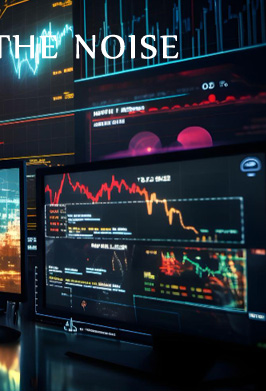What are Technical Indicators for Stocks?
Technical Indicators involve a wide variety of mathematical calculations based on historic price, trading volume, or open interest information intended to help investors predict the direction of price movements. Technical Indicators play vital role in any kind of stock trading strategy as they are the most essential tools of Technical Stock Analysis. Mated to proper risk management tools, they could assist investors to be provided more insight into trends to make stock price prediction a less grueling task. The best trading strategies include different types of indicators combined, such as a momentum indicators, volatility indicator and a trend-following indicators.There is a trove of different type Trading Indicators often categorized as leading and lagging indicators. A leading indicator is a forecast signal that predicts future price actions, while reversely a lagging indicator is related to past trends and points out momentum.
Did you know? The simplest Technical Indicator is a trendline.
We listed a cluster of indicators in order of their importance and popularity in Day Trader's prospect.
» Moving average (MA or SMA)
» Exponential moving average (EMA)
» Bollinger bands
» Moving average convergence divergence (MACD)
» Average directional index (ADX)
» Relative strength index (RSI)
» Stochastic oscillator
» Supertrend indicator
» Fibonacci retracement
» Ichimoku cloud
» Standard deviation
 TECHNICAL INDICATORS
TECHNICAL INDICATORS
Moving average (MA)
The Moving Average or Simple Moving average (SMA) is a great tool to identify the direction of a current price trend, without the interference of short-term price hikes. MA combines stock's price points of a pre-defined time period, and divides it by the number of points to form a single trend line. Moving Average Technical Indicator refines price movements to shape patterns that visualize trends pretty well. Moving averages signal investors when markets are overbought and oversold relative to average stock price.Exponential moving average (EMA)
Exponential moving average is not dissimilar to Simple Moving Average (SMA) but unlike SMA it indicates trend direction over a period of time. Whilst SMA simply takes an average of price points, EMA weighs out the current price data that lends the indicator more responsiveness to fresh price movements. When coupled with other indicators, EMA helps investors to confirm significant price movements and verify their validity.Bollinger bands
A Bollinger band is an indicator that provides a price range within which the stock price fluctuates. The width of the band increases and decreases where lines' move represents recent volatility. The closer the bands are to each other the lower the stock's calculated volatility. Oppositely, the wider the bands, the higher the volatility.By dint of their flexibility and visually intuitive attribute Bollinger Bands are apt to identify price movements when stock is trading outside of its usual range. Though typically they are employed to predict long-term movements, they often might be expedient for Day Traders to spot oversold and overbought conditions in addition it's easy to interpret. Until the price moves outside the upper points of the band, stock is likely overbought, and when it moves below the lower band, it is oversold. This feature might signal trend changes that can provide a wealth of benefits to Day Traders to make buying and selling decisions.

|

|

|
Moving average convergence divergence
Moving average convergence divergence is a valuable indicator that was designed to reveal changes in momentum by comparing two moving averages displayed with plots of them; the MACD line and the signal line. It helps investors identify the most beneficial entry and exit point near support and resistance levels. Convergence refers to the conjunction of two moving averages, whereas divergence means that they are departing. Simply defined convergence refers to a decrease in momentum whereas divergence refers to increase.MACD line is calculated by subtracting a pre-determined exponential moving average (EMA) - typically calculated for 26-day periods from a shorter-term simple moving average (SMA), usually relevant to 12-day periods.
The signal line is a moving average of the MACD line, usually relevant to 9-day periods. When two lines converge, MACD line stays close to the signal line. This indicates a slowdown of current trend and signals a possible reversal. When the two lines diverge, MACD line is varying quicker than the signal line, and this signals momentum increase in the current trend.
MACD is useful for Intraday Traders to confirm trends and anticipate imminent changes in the trend especially with MACD crossover strategy that relies on a simple method. When MACD line crosses above the signal line, a bullish 101 signal is triggered and when MACD line crosses below the signal line, it is considered a bearish signal.
Average directional index (ADX)
Average directional index helps traders appraise the trend strength, and acts as an oscillator displayed below the stock charts. ADX is typically based on a 14-day moving average adapted to investor's time-frequency settings. ADX doesn't point out trend directions but it simply indicates the trend's strength. Simply analyzed, ADX can go up when a price is falling, that signals a strong upcoming downtrend.The index is plotted from 0 to 100 where a value above 25 indicates a strong trend, and 25 or below means a weak trend or no trend at all.
Commonly ADX is used in par with any momentum-based strategy that together can pinpoint a buying or selling decision. Investors with mid- to long-term time horizon as well as Day Traders can use the average directional index magnificently, to help confirm trend turns if they have been verified by another indicator. ADX is often deployed by Intraday Traders in short-term charts to be enabled to perceive short-term price fluctuations more sensitively.
Relative strength index
The relative strength index is a momentum indicator that measures the volume of recent price movements and its primary goal is to identify overbought or oversold conditions. It oscillates between 0 and 100. Commonly the RSI is considered overbought when above 70 and oversold when below or near 30. An overbought condition suggests that short-term price actions may be matured to spark a trend turn with a price correction. Oppositely an oversold condition could signal a short-term decline is reaching its maturity point and past a trend turn stock price may rise or may be subject to rally.RSI offers multiple benefits to all types of investors and helps them promptly identify momentum increase or decrease, market conditions and danger signals for unusual price movements that should be avoided due to elevated risk factor. RSI is an indispensible indicator for a Day Trader because it pre-indicates possible trend turns with great precision - with the help of lower RSI period settings as 9 to 11 - even in case of trifle changes, and is supportive when it comes to identifying and tracing down following trends.
Stochastic oscillator
The Stochastic Oscillator is an indicator that compares the stock's most recent closing price to the highest and lowest prices for a determined timeframe. Its reading oscillates between 0 and 100 and unequivocally indicates the stock's momentum. In general the stochastic oscillator gives an overbought signal about the market when above 80 and oversold when below or near 20.For short-term trading strategies, such as Intraday Trading, shorter time periods are set for the chart like hourly, minutely movements or even seconds. By means of its simplicity in term of both methodology and reading, stochastic oscillator can be successfully deployed for setting limit orders as trailing stop loss orders.
Supertrend indicator
Supertrend indicator indicates the price movements' direction of a stock in a trending market. It's important to know that it yields minimum to zero value if market goes sideways and no trend is formed. It is displayed in stock charts allowing investors to track down current market trend with data points, colored with red when prices have dipped and green when prices have risen. The Supertrend indicator combines the average true range (ATR) with a unique multiplier to calculate its dataset. This dataset is added to, or subtracted from the stock's closing price to draw the supertrend line.The SuperTrend Indicator is a valuable tool for investors to precisely identify market trends with no delay, and to determine the most prospective entry and exit points. It plays a crucial role in Intraday Trading Strategies due to its simplicity and adaptability to all sorts of Day Trading techniques and other indicators.
Fibonacci retracement
Fibonacci retracement is an indicator was designed to point out the extent to which a market will move against its current trend. A retracement point is when a temporary dip occurs in the stock market referred to as pullback. In technical analysis its main purpose is to determine support and resistance levels. The name stems from Fibonacci sequence of numbers, whose ratios pinpoint price levels to which markets tend to "retrace" for a while, before a trend continues to drive in the original direction. Fibonacci retracement works nearly flawless when the market is trending.In a nutshell, Fibonacci retracement tool plots percentage retracement lines drawn by price points determined according to the Fibonacci sequence. These retracement levels indicate support and resistance levels that are commonly considered as target buying and selling price objectives. Though the Fibonacci retracement method is rather for savvy stock traders and sounds like a rocket science its use in the reality is far simpler. To spot Fibonacci retracement levels, you have to find the recent major swing highs and swings lows. Then, in case of downtrend, click on the swing high in the chart and drag the cursor to the most recent swing low. In case of uptrend, do the opposite.
Intraday Traders who anticipate otherwise unexpected market moves often employs Fibonacci retracement to confirm their theory since it assists them to identify support and resistance levels, which could signify an up- or downtrend. What makes this tool stand out from the crowd is the potential opportunity to accurately discern support- and resistance levels, which is what can help traders to determine where to apply stops and limits, or where to entry and exit a trade.

|

|

|
Ichimoku cloud
The Ichimoku Cloud is a technical indicator shown as a cloud on a stock chart and serves as a snapshot of the global stock market trend. Its task is to determine support and resistance levels, signal momentum in a stock and trend direction and similarly to other momentum indicators it gives feasible buy- and sell signals. The translation of 'Ichimoku' that means 'one-look equilibrium chart' suggests it is capable to supply investors a bunch of information at once just from one chart. Being the key 'substance' of 'Ichimoku', TenkanSen and KijunSen are similar to moving averages and analyzed in context to one another. Simply put, when TenkanSen and KijunSen are definitely above the cloud, the imminent trend is positive. When TenkanSen and KijunSen are decidedly below the cloud, imminent trend is negative.Standard deviation
Standard deviation is used for measuring market volatility, particularly to what extent stock prices diverge from the average price. If stock prices stay in a narrow range, the standard deviation will return a low value as a mark of low volatility and vice versa. Standard deviation is an indicator that helps investors to appraise the size of price moves and therefore they can identify the probability of volatility's influence on future prices. However it is not able to predict coming movements if the price will rise or fall.Standard deviation method compares current price movements to historical price movements. Investors using this tool often assume that after small price movements one big price movement will occur and reversely, and small price movements follow big price movements.
 HELP WITH ANALYSIS
HELP WITH ANALYSIS
Key Takeaways
To avoid discrepancies from real price movements it is highly recommended to use a handful of these indicators in tandem with each other. If using just one individually, you might be delivered false signals, especially in sideway markets when stocks are not trending strongly or not trending at all, or when market is bamboozled with unforeseen stock catalysts; events, announcements or news.You should exploit your own skills and involve your risk appetite to weigh out pros and cons, and them decide which of the stock indicators would fit your trading strategy.
 HELP WITH ANALYSIS
HELP WITH ANALYSIS
Then if you are ready to learn a few weeks then work relentlessly 3 hours daily, don't dump the vision about a Financial Freedom, and Create a From-Home Career. Should you have stock-basics knowledge or you just start from scratch, our unparalleled News Impact Evaluation System will bring the light to the opportunity of massive gains. Get BNA's Real-Time Updates at your fingertips latest US Company News that will induce stock's price-rice soon after market-open with the highest likelihood.





